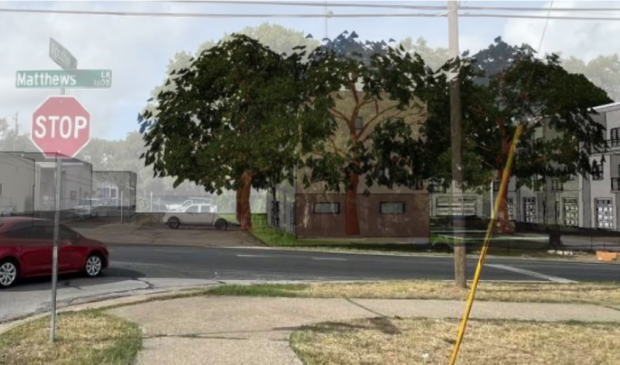City reverses decision, granting variance from compatibility in storage unit case
Wednesday, November 30, 2022 by
Elizabeth Pagano City Council is set to consider the topic of compatibility on a larger scale Thursday. Meanwhile, the Board of Adjustment took a second swing at the issue on a more granular level, voting at its last meeting to overturn a previous denial of a compatibility variance in South Austin.
The applicants were seeking a variance to the compatibility standards triggered by nearby storage units that sit on a lot zoned for single-family use. Compatibility limits the development of buildings located near single-family homes as determined by a property’s zoning.
A previous vote fell short of the number of votes required to grant the variance. The board subsequently voted to reconsider the case, and in a vote of 8-2* granted a reprieve from the regulations that limit height and dictate setbacks for developments next to residential zoning. Board members Barbara Mcarthur and Darryl Pruett voted in opposition to the variance.
“This kind of feels like we are making a decision on compatibility and how it’s defined, but at least for me, this is somewhat an easy vote,” Chair Jessica Cohen said. “Every unit this size we can build on the west side is one less family that’s gentrified out of their single-family home on the east side. So I 100 percent support this.”
Cohen’s support was not shared by a number of neighbors who expressed their opposition, citing concerns that the project was a bad fit for the neighborhood and would increase flooding.
Ruth Lauer told the board she lives in the area in addition to owning a rental duplex on Matthews Lane. Lauer objected to the notion that building more densely will make the units cheaper, saying, “The economies of scale may be true for making widgets, but the real estate market has its own rules.” She said that the new homes will sell at the market rate “and three affordable units will be demolished in the process.”
“I’m not against housing, if it is sustainable, affordable and consistent with the neighborhood,” Lauer said. “This would be a great project if it was close to a transit corridor. It is not. Nor does it meet the need for affordable homes.”
“When does no mean no?” Lauer added. “The conditions that the owner is calling hardships all existed when he bought the property …. And the group of Plano investors should have revealed them in their due diligence. They are common to many lots in the area.”
Karen Fernandez, who is the current president of the Matthews Lane Neighborhood Association, also spoke in opposition.
“Wanting nine units, not 10, is not a hardship,” she said.
Fernandez explained that the storage units were a small business allowed on residential property that was permitted prior to annexation by the city in 1984. Though the commercial use is a grandfathered right for that specific business, future commercial development of that property would not be allowed. She argued that the variance in question for 1609 Matthews Lane would actually create a hardship for the neighboring lot in the future.
Victoria Haase, representing the owner, explained that the compatibility regulations combined with building restrictions imposed by heritage trees, a critical water quality zone and a public utility easement do not allow for reasonable use of the property at 1609 Matthews Lane. All told, the various site constraints prevent building on 60 percent of developable area, she said.
Since the last hearing, the project’s architect worked to reduce encroachment into the compatibility setbacks. Haase noted that the project is 31 feet in height at its tallest, which is not as tall as the height permitted for the home next door. In addition, the tallest parts of the project would be 130 feet from any single-family use in the neighborhood. The applicants also researched the intent of compatibility standards and similar cases that had received variances in the past.
“Everybody wants affordable housing, everybody wants additional units, but not in my backyard, not next to me,” Board Member Michael Von Ohlen observed. “I’m not here to enforce homeowner association rules. I’m not here to enforce deed restrictions …. I empathize, but that’s not my job.”
“If we’re going to get serious about housing in the city of Austin in a manner without just blowing smoke up everybody’s ass,” he continued, “we’re gonna have to make some hard decisions that some people, quite frankly, are going to be upset about.”
Mcarthur said she considered the concerns of the neighborhood valid, noting “they’ve accepted a whole lot more density in their area” with the original zoning case. “I would hardly call the people speaking against the variance NIMBY,” she said.
Von Ohlen clarified that his comment was meant to be applied citywide and was not aimed at any individuals in particular.
“We see it in neighborhoods all over,” he said.
* A similar variance was previously denied on a vote of 8-3, which would have required nine votes to pass. A spokesperson for the board explained that this time, with only 10 members voting, eight votes was sufficient to approve the variance.
Photo caption: Rendering shows the townhome project and the mini storage units (left) that trigger compatibility. Rendering by Heimsath Architects.
The Austin Monitor’s work is made possible by donations from the community. Though our reporting covers donors from time to time, we are careful to keep business and editorial efforts separate while maintaining transparency. A complete list of donors is available here, and our code of ethics is explained here.
You're a community leader
And we’re honored you look to us for serious, in-depth news. You know a strong community needs local and dedicated watchdog reporting. We’re here for you and that won’t change. Now will you take the powerful next step and support our nonprofit news organization?








